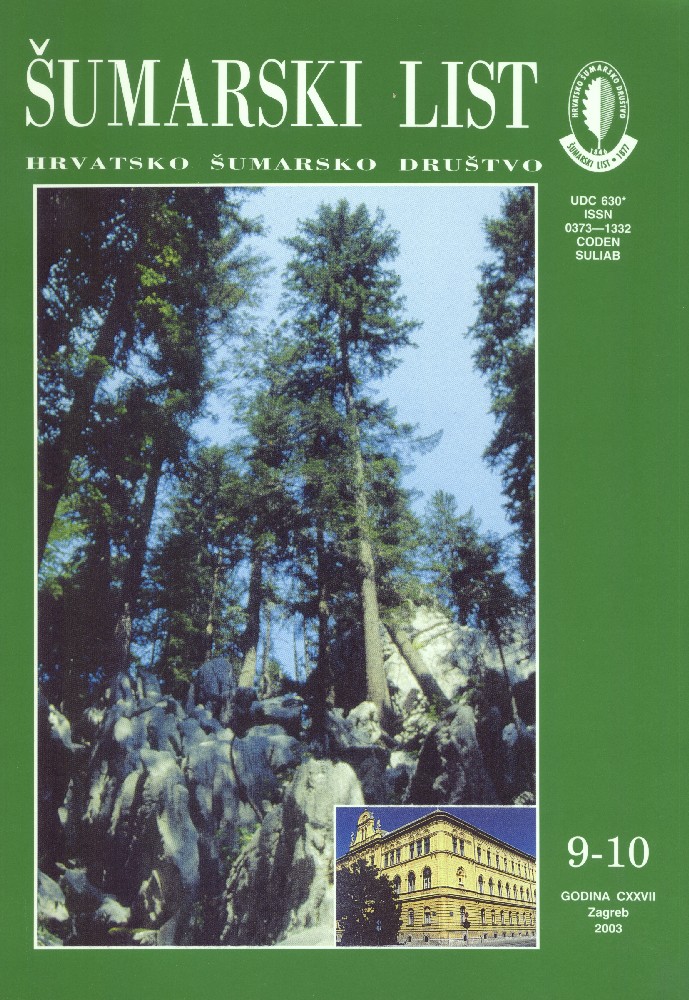
broj: 9-10/2003
pdf (21,7 MB) |
|
||||||||||||||
| IZVORNI ZNANSTVENI ČLANCI | ||
| Idžojtić, M. | UDK 630* 442 (001) | |
| Hosts and Distribution of the White-berried Mistletoe (Viscum album L. ssp. album) in Croatia pdf HR EN | 439 | |
| Krejči, V., Dubravac, T. | UDK 630* 231 + 226 (001) | |
| Possibility and Justification of the Shelterwood Cutting Method in the Beech Forests of Gorski Kotar, Lika and Hrvatsko Primorje pdf HR EN | 449 | |
| Klobučar, D. | UDK 630* 583 + 585 (001) | |
| Assessment of the Accuracy of Geocoding the Basic Map of Croatia and the Digital Orthophotography pdf HR EN | 457 | |
| PRETHODNO PRIOPĆENJE | ||
| Prka, M. | UDK 630* 443 + 323 + 325 | |
| Occurrence of False Heartwood in Beech Trees and Technical Beech Roundwood Coming from Thinning and Preparatory Fellings in the Area of Bjelovar Bilogora pdf HR EN | 467 | |
| STRUČNI ČLANCI | ||
| Margaletić, J., Margaletić, M. | UDK 630* 435 + 432 | |
| Fires in Forests and Forestlands as Habitat Degradation Factors pdf HR EN | 475 | |
| Sabadi, R. | UDK 630* 904 | |
| German Forestry in 2002/2003 pdf HR EN | 483 | |
| Tolić, I. | UDK 630* 164 + 160 + 261 | |
| Commercial and other Values of the Genus Pistacia Species pdf HR EN | 501 | |
| Summary: Large degraded areas of formerly valuable high forests in the Croatian Mediterranean and sub-Mediterranean region belong to the natural distribution range of the genus Pistacia: mastic tree (Pistacia lentiscus L.) and terebinth tree (Pistacia terebinthus L.). For a long time, these species were neglected by the forestry profession, or better put, their commercial and other values were not recognised. The author of this article has not found much data on the species of the genus Pistacia in the available literature, and even less on the ameliorative properties of the Mediterranean karst. These are two autochthonous species, which have always had a significant and useful function in their natural Mediterranean range. The Mediterranean area has for centuries suffered from a shortage of all timber assortments. It is for this reason that the wood of the genus Pistacia species, and particularly of P. terebinthus, has been widely applied in woodwork, turnery and in the manufacture of wooden tool parts, due to its hardness, firmness, easy processing and varnishing. The Pistacia wood is also good as fuelwood as it contains resin. The rooms in which it burns are permeated by a very pleasant smell. Other parts of the plants of this genus have found their use in the chemical industry, medicine, and other fields. On occasions, due to severe droughts and the absence of other cattle food in warmer parts of the Mediterranean, the leaves (bushes) were picked and dried to be used as a substitute, however inadequate, for sheep and goat food. Unripe fruits (grapes) in particular were picked and given to sheep as nourishing food. The species of this genus has not found a suitable ameliorative application in forestry although these plants have a well-developed root system and are distinctly xerophytic. They tolerate poor sites well, while their good shooting vigour makes them a constitutive part of maquis and warmer parts of deciduous coppices. After a fire they regenerate well from stumps. Apart from the two autochthonous Croatian species, the far better known common pistachio (Pistacia vera, L.) is grown for its edible and very tasty fruit both in the Mediterranean region and wider. The intention of the author of this article is, among other things, to advocate the cultivation of this species for its fruits and enrichment of fruit tree assortment in the Croatian Mediterranean region. This possibility is particularly stressed because the two existing autochthonous species growing in their natural sites may serve as good stock for grafting the common pistachio. Key words: mastic tree; terebinth tree; common pistachio; evergreen; deciduous; plumate leaves; bush; low tree; diclinous; dioecious; entomophilic; xerophytic; sea spray; Mediterranean; fruit; drupe; seed; edible; tasty; nourishing; cultures; mastic; root system | ||


